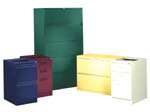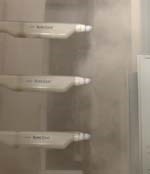Powder Brings Out Maysteel's True Colors
Rapid color-change helps lead to manufacturer's dramatic production increases...
At first glance, Maysteel's manufacturing facility in Menomonee Falls, Wisconsin, looks like a typical stamping and metal fabrication operation. But a closer look at its manufacturing process, and its finishing line in particular, reveals an operation that is anything but typical.
Maysteel's Precision Enclosures Group manufactures furniture, and electrical and telecommunications enclosures for a blue-chip roster of clients—including IBM, Cisco, Allen Bradley, Rowe and Haworth. The parts that Maysteel manufactures range from small fan plate enclosures to large computer server cabinets and even larger vending machine bodies.
Featured Content
Competition can get pretty intense for outsource manufacturing, so Maysteel works hard to keep its big-name customers satisfied by keeping its costs inline and its quality high. Consistent quality gives the company an edge, but the ability to turn on a dime for its customers really sets Maysteel apart.
"Through our prototype center, we have the ability to quickly design and develop new products so we can respond right away to our customers' production needs," said George Bush, manufacturing engineer, Paint/Assembly. "Our biggest strength is our ability to meet the ever-changing needs of our customers."
Until last year, Maysteel relied on a labor-intensive liquid coating operation for its finishing line. However, the manufacturer wanted to improve product quality while increasing production capacity. With more than 60 standard colors used on its finishing line, that also meant Maysteel needed efficient, quick-color change capabilities.
"We absolutely had to have quick color change because of the diversity of products we coat and our lean manufacturing production schedules," said Mr. Bush. Seeking a powder-coating solution to this requirement, Maysteel set two ambitious goals—spray-to-waste color changes in six minutes and reclaim-to-reclaim in 15 minutes.
Maysteel selected the ColorMax® system from Nordson, which appeared to offer the fast, easy color changes. To prove it, Maysteel spent a week at the Nordson customer testing lab, running and re-running dozens of its parts.
The New Finishing Line
Convinced the booth would work, Maysteel wasted no time in making the switch to powder. The company built a new environmental room and installed the powder spray system for automated coating, and two Nordson® Versa-Coat® walk-in booths for pre- and post-reinforcement. In less than 24 hours, Maysteel's coating operation went from wet to total powder and was back to full production levels in only three days.
Maysteel coats a variety of substrates for its customers, such as cold-rolled and electrogalvanized steel, G-30 material and aluminum. To properly treat such a range of materials, products enter the powder coating operation by way of an eight-stage pretreatment process built by ITS. Parts then move into a 325F dry-off oven before moving into the environmentally controlled coating room.
Because of the complex configurations of a number of products coated, Maysteel typically uses a combination of the three spray booths during the coating process. Parts enter a walk-in spray booth, where one operator manually applies powder to the Faraday cage areas where automatic guns cannot reach. A part identification system then identifies the parts and selects parameters for gun triggering and gun positioning before moving into the spray booth. There, 16 automatic Nordson® Sure Coat® spray guns apply powder anywhere from two to five mils, depending on customer specifications. The system has two 16-gun feed centers with the capability to feed from a 50-lb box or 75-lb fluidized hopper.
Parts are then conveyed to another walk-in booth where two operators manually apply powder for post-touch up of inside corners of boxes, if needed. Maysteel also uses the pre- and post-reinforcement manual booths to coat smaller one- or two-piece color runs.
According to Mr. Bush, the three-booth system is ideal for Maysteel's lean production schedules. "Altogether, the system gives us the most flexibility to meet each customer's unique needs."
Powder coating materials are supplied by Sherwin-Williams, IVC Industrial Coatings, HB Fuller, Morton, DuPont and Interpon.
Following the coating process, parts move to a curing oven for 25 minutes, typically baking at 365F before being conveyed to an assembly area. The finishing line runs at a constant 14 fpm, with a complete trip from the hanging area to assembly area lasting two hours.
The Multicolored Pluses of Powder
"We've increased line densities, even doubling them in some cases, through automation and quick, cost-effective color changes," said Mr. Bush.
For example, where Maysteel previously hung six 12-inch cabinet drawer fronts on the finishing line, nine are now being hung. Where one cabinet hung before on a four-foot center, now two are hung. Parts are hung and coated in sets, so when they come off the line, they are kitted and can go right into build cells in assembly. With this increased production capacity, manual intervention has decreased significantly.
A number of quick color-change features of the system means Maysteel easily met its immediate goal to use more colors more efficiently, and coat more products more quickly. That's been critical to meet lean manufacturing production schedules with maximum operating efficiencies. It's also meant daily production schedules can be met even with an average of 20 to 25 or more color changes in an eight-hour shift.
Dramatic improvements in efficiency on the finishing line haven't been the only benefits of switching to powder. Powder coatings are proving to be more durable, which hasn't gone unnoticed by customers.
"We've always focused on quality, but our customers have been impressed with the consistent mil coating and coverage, and overall quality we're providing with powder. With some products, we're seeing five times more corrosion resistance," said Mr. Bush.
The move from liquid to powder has also taken Maysteel out of the hazardous waste handling business, which has meant decreased disposal costs, saving an estimated $5,000 per month. It's also meant less paperwork for environmental reporting and less labor needed for related data gathering.
Quality Control is Key
With its high-profile consumer customers, quality control throughout its operation gets close attention at Maysteel. Quality in its finishing area begins with a finely tuned operation, with every detail for each product outlined on extensive process control sheets. The sheets cover everything from hanging to pretreating and coating to assembly. Such meticulous detail ensures consistent, repeatable quality across the finishing line.
The sheets tell hangers exactly how to hang parts, how many of each part to hang, and which parts to group together for easy assembly at the end of the line. The sheets also tell hangers what breaks to leave on the line to allow for color changes. During the coating process, system operators refer to the sheets for each booth to know what gun settings and modes to use and what areas of the part to coat in the manual booths.
Quality control also extends to an extensive preventive maintenance schedule. Two employees spend an entire shift each night going through a two-page list that covers such areas as cleaning the powder spray booths, ultrasonically cleaning gun tips and rotating all venturi pumps. More in-depth maintenance is performed on a bi-weekly and monthly basis, all of which means the finishing line can run at peak performance every day.
Growing the Business Now, Later
The move to powder coating has been everything Maysteel's Precision Enclosures Group wanted—and more. Efficient, quick color changes. Greater production capacity. Better quality. It's also helping bring in more work from existing customers. And, Maysteel has created extra capacity needed to continue growing its business.
"Our powder coating operation gives us the flexibility we need to meet the production requirements of our customers—whether that means they need one filing cabinet in 15 different colors or 1,000 in one color," said Mr. Bush. "Looking at all the benefits, we now have a substantial and sustainable competitive advantage."
RELATED CONTENT
-
Coating Systems with the Best Long-Term Performance
The best protection against corrosion and UV exposure, says Axalta’s Mike Withers, is electrocoat and a super durable powder coating.
-
Powder Coat MDF for an Enviable Finished Product
Cabinet maker says powder coating on wood offers more benefits.
-
Improving Transfer Efficiencies in Coating Operations
There are many methods for addressing electrostatic grounding in metal painting processes, and Tim Ulshafer from Mueller Electric says the best method for your process is a simple and worthwhile exercise.





















